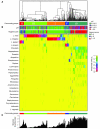Vaginal microbiome and sexually transmitted infections: an epidemiologic perspective
- PMID: 22133886
- PMCID: PMC3225992
- DOI: 10.1172/JCI57172
Vaginal microbiome and sexually transmitted infections: an epidemiologic perspective
Abstract
Vaginal bacterial communities are thought to help prevent sexually transmitted infections. Bacterial vaginosis (BV) is a common clinical syndrome in which the protective lactic acid-producing bacteria (mainly species of the Lactobacillus genus) are supplanted by a diverse array of anaerobic bacteria. Epidemiologically, BV has been shown to be an independent risk factor for adverse outcomes including preterm birth, development of pelvic inflammatory disease, and acquisition of sexually transmitted infections. Longitudinal studies of the vaginal microbiome using molecular techniques such as 16S ribosomal DNA analysis may lead to interventions that shift the vaginal microbiota toward more protective states.
Figures


Similar articles
-
Vaginosis. Vaginal microbiota.Enferm Infecc Microbiol Clin (Engl Ed). 2019 Nov;37(9):592-601. doi: 10.1016/j.eimc.2018.11.009. Epub 2018 Dec 26. Enferm Infecc Microbiol Clin (Engl Ed). 2019. PMID: 30594321 Review. English, Spanish.
-
Vaginal microbiota and viral sexually transmitted diseases.Ann Ig. 2013 Sep-Oct;25(5):443-56. doi: 10.7416/ai.2013.1946. Ann Ig. 2013. PMID: 24048183 Review.
-
[Characteristics and physiologic role of female lower genital microbiome].Orv Hetil. 2023 Jun 18;164(24):923-930. doi: 10.1556/650.2023.32791. Print 2023 Jun 18. Orv Hetil. 2023. PMID: 37330978 Review. Hungarian.
-
Mycoplasma, bacterial vaginosis-associated bacteria BVAB3, race, and risk of preterm birth in a high-risk cohort.Am J Obstet Gynecol. 2014 Mar;210(3):226.e1-7. doi: 10.1016/j.ajog.2013.10.003. Epub 2013 Oct 4. Am J Obstet Gynecol. 2014. PMID: 24096128 Free PMC article.
-
Parallel detection of lactobacillus and bacterial vaginosis-associated bacterial DNA in the chorioamnion and vagina of pregnant women at term.J Matern Fetal Neonatal Med. 2019 Aug;32(16):2702-2710. doi: 10.1080/14767058.2018.1446208. Epub 2018 Mar 12. J Matern Fetal Neonatal Med. 2019. PMID: 29478370 Free PMC article.
Cited by
-
Anti-Biofilm Properties of Saccharomyces cerevisiae CNCM I-3856 and Lacticaseibacillus rhamnosus ATCC 53103 Probiotics against G. vaginalis.Microorganisms. 2020 Aug 24;8(9):1294. doi: 10.3390/microorganisms8091294. Microorganisms. 2020. PMID: 32847138 Free PMC article.
-
Preventing sexually transmitted infections: back to basics.J Clin Invest. 2011 Dec;121(12):4580-3. doi: 10.1172/JCI61592. Epub 2011 Dec 1. J Clin Invest. 2011. PMID: 22133882 Free PMC article.
-
Vaginal microbiota and human papillomavirus: a systematic review.J Turk Ger Gynecol Assoc. 2020 Sep 3;21(3):193-200. doi: 10.4274/jtgga.galenos.2019.2019.0051. Epub 2019 Sep 30. J Turk Ger Gynecol Assoc. 2020. PMID: 31564082 Free PMC article.
-
The role of metagenomics in understanding the human microbiome in health and disease.Virulence. 2014 Apr 1;5(3):413-23. doi: 10.4161/viru.27864. Epub 2014 Feb 11. Virulence. 2014. PMID: 24429972 Free PMC article. Review.
-
Comparison of the vaginal microbial communities in women with recurrent genital HSV receiving acyclovir intravaginal rings.Antiviral Res. 2014 Feb;102:87-94. doi: 10.1016/j.antiviral.2013.12.004. Epub 2013 Dec 19. Antiviral Res. 2014. PMID: 24361269 Free PMC article.
References
-
- Hillier SL, Holmes KK, Marrazzo JM. Bacterial vaginosis. In: Holmes K, et al.Sexually Transmitted Diseases . New York New York, USA: McGraw–Hill, Health Professions Division; 2008:737–768.
Publication types
MeSH terms
Grants and funding
LinkOut - more resources
Full Text Sources
Molecular Biology Databases

